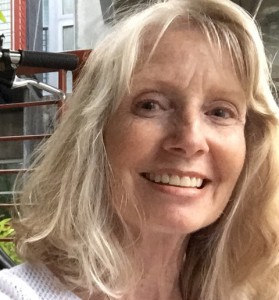This past weekend was the annual Tour des Chutes — a multi-distance cycling event and walk/run in my hometown to help local families dealing with cancer. Founded by cycling enthusiast and brain cancer survivor, Gary Bonacker, the event has surpassed the million-dollar mark in fundraising. Which is pretty amazing for a small-town, grassroots venture.
But then, my friend, Gary, is pretty amazing. Because he’s been instrumental in this endeavor with part of the brain tumor that couldn’t be removed surgically still causing havoc all these years. If anyone knows how to do life with cancer, it would be Gary.
After Hubby and I worked through the initial devastation that came with his diagnosis, we drafted a cancer team. The goal was for him to live as long as possible, of course. But we also wanted quality of life for him.
Our cancer team looked a lot like this list — a dozen simple ways to get back into life while dealing with the hard:
Volunteer for a worthy cause. Hubby volunteered three mornings a week at the local men’s rescue mission. And loved it. Apparently there’s plenty of science to back up the idea that volunteering is good for your mental and physical health. A Healthy Women article, entitled “The health benefits of volunteering”, indicates that “people with chronic pain who volunteered as peer counselors found that their pain, disability and feelings of depression all lessened from volunteering.”
Try something challenging. This is referring to something you don’t really want to do, but you know you should. Sort of an Anti-Bucket List. Like public speaking. Or writing that letter of apology you should have written long ago. I’ve been doing a series of brave-making things since Hubby died: A walking tour in Switzerland, visiting places alone where he and I had been together. And with each challenge met, I feel stronger and braver.
Draft a list of things you’ve always wanted to do. Hike the Grand Canyon rim to rim. Bake a perfect soufflé. Learn to speak Russian. Research your family tree. I’ve looked wistfully at stand-up paddle boarders, wishing I could do this amazing thing of balancing on a surfboard while rowing standing up. And then I had the opportunity to take SUP lessons. Talk about fun! (And I only fell off once.)
Get outdoors. There are so many fabulous memories of hiking the Cascades, Rockies, Tetons with Hubby – summiting a tall trail, sitting with our backs to the sun, drinking in the views. A Health.com article, “5 (scientific!) reasons getting outside is good for you”, maintains that just being outdoors can ease depression, improve outlook and focus, and strengthen immunity. (I’m sitting outdoors as I write this … and feeling quite healthy.)
Get outdoors and walk. Most of us are familiar with the benefits of physical activity — increased energy and decreased depression and stress, to name a few. And when you combine physical activity with being outdoors, that’s a double whammy to stress.

Get outdoors and walk for a worthy cause. Yes, this past weekend. The Tour des Chutes 5K in memory of Hubby. A triple whammy.
Get outdoors and walk for a worthy cause with a bunch of goofy people who know how to do life well after cancer. I am a life-time member of a magnificent, astonishing, laughter-filled, cancer-kicking walking group. We walked the Tour des Chutes together. Believe me, these people know how to do life well.
Enjoy coffee or tea with said group of goofy cancer-kicking people. An article entitled “13 proven health benefits of coffee” claims that coffee can improve energy levels, make you smarter and help burn fat. And apparently there are essential nutrients in coffee beans: Riboflavin, manganese, potassium, niacin. Who knew? As for tea, according to Today, “How a daily cup of tea may improve your health”, tea is an antioxidant (think anti-rust agent). Tea also may help with weight loss, protect bones and boost immune system. Go find your own group of goofy cancer-kicking people, and be sure to include coffee/tea in the activity.
Eat healthfully. Eating nutritiously helps control weight, improve moods, combat diseases and improve longevity. And coupled with physical activity, it’s that much more effective. When Hubby was diagnosed, we somehow knew that building as strong a body as possible would help battle the onslaught of cancer and the side affects of treatment.
Manage the stress. Hubby’s and my go-to tactic for managing stress was anything outdoors — lacing up hiking boots, strapping on snowshoes, conquering the nearby trails. Gardening, adopting a pet, volunteering (see how everything is tied together), talking with someone and maintaining a good sense of humor are among the many ways to help manage the stress of cancer.
Collect your thoughts on paper. Writing about personal experiences can improve mental, physical and emotional health. Dr. Timothy D. Wilson says, “Writing forces people to reconstrue whatever is troubling them and find new meaning in it.” Write out your frustrations and anger, your hopes and dreams, the things you’re grateful for. Track where you are in life and what you’re learning along the way. And see if you can’t find meaning in the hard.
Make a new friend. Cancer introduced us to a full community of some of the most amazing people on the planet. My co-workers in the cancer center; the people we served; the cancer community across the country as we traveled and shared our story. Keep your old friends, but intentionally make a new friend. You never know who might need your friendship.
Hopefully you’ve noticed a trend with this list: Learning to rebuild a life with and beyond cancer involves people. It involves getting off the couch and learning new things. It involves reaching out and giving back. What are you doing to get back into life? I’d love to hear your ideas and thoughts!
Nice tips.. Thanks for sharing.
Thank you, Sunidhi!
thanks very much for sharing this inspiring article.